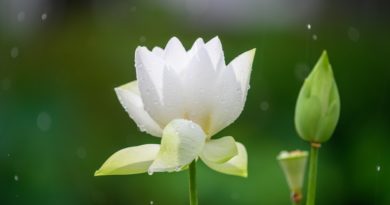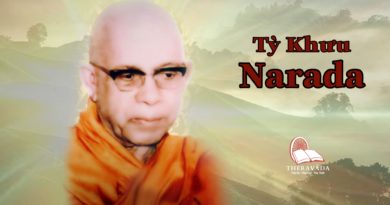DHAMMA PADETHA – 24. ORDAIN AS DULLABBA MONKS TO GAIN BENEFITS
DHAMMA PADETHA – ORDAIN AS DULLABBA MONKS TO GAIN BENEFITS
Nowadays there are more ordination ceremonies to become dullabha monks in Myanmar than in the olden days. If they can practise according to the term ‘dullabha’, these monks will have lots of benefit till they reach nibbana. Depending on the dullabha monks the sasana will also progress, flourish and have much benefit.
If they cannot practise in keeping with the term ‘dullabha’ they will be degraded till they reach apaya. Because of them the sasana will also deteriorate or degenerate. That is why for their own benefit and for the benefit of the sasana, dullabha monks must practise accordingly.
What the majority of the people understand the word ‘dullabha’ is, entering monkhood temporarily and become lay again.
In reality the term dullabha does not mean entering monkhood for a short duration of time and become lay again. It means, dullabha monks are people who try to attain what is difficult to attain.
In the word dullabha, ‘du’ is one word and ‘labha’ is another word; du-that is difficult labha-attaining or trying to get. Dullabha, monkhood that is difficult to attain, but tries to attain is the meaning.
Dullabha monkhood is difficult to attain because laity cannot attain or try and fulfil the (227) rules of training (sila sikkhapada) which, when expanded become more than ninety thousand millions or nine thousand kotis. Only when these numerous rules can be observed, sila merit can be obtained. That is why dullabha means attaining what is difficult to attain.
Concerning ordination of dullabha monks there are five types of people which should be known. Together with dullabha monks there are five kinds of people who enter monkhood in the sasana.
(1) Saddhapabbajita — enter monkhood because of faith
(2) Pannapabbajita — enter monkhood due to wisdom.
(3) Bhayapabbajita — enter monkhood be cause of fear
(4) *Miyophalapabbajita— enter monkhood due to tradition [* Miyophala (Myanmar word) means traditional.]
(5) Dullabhapabbajita — enter monkhood because he wishes to attain what is difficult to attain.
(1) Saddhapabbajita—entering monkhood because of faith. An individual hears about Buddha, Dhamma, Sangha or Triple Gems and believes or have faith in them. Depending on his faith he becomes a monk and is known as saddhapabbajita.
Because this monk believes in the Triple Gems and is respectful he will observe sila, the rules of training, without breaking them. He reveres his teacher and colleagues. He practises Kammatthana ardently so as to be free from samsara, rounds of rebirth. Because of his practice and qualities of virtue, he becomes a pride for the Sasana.
(2) Pannapabbajita—entering monkhood due to panna or wisdom.
An individual studies Buddhist Pitakas and scriptures and also listen to them. Hence, he progresses in his knowledge and wisdom. Depending on that, he becomes a monk and is known as Pannapabbajita-a monk due to panna. This type of monk only respects pitaka scriptures and learning them. He is not interested in the affairs of the sasana. He simply tries not to oppose others. However, when he becomes a learned monk in pitakas and scriptures he will be fully endowed with faith and knowledge. Hence, he can eventually become the pride of the sasana.
(3) Bhayapabbajita—entering monkhood due to fear.
An individual becomes a monk because of some crime he had committed or because of the problems of food, clothing and shelter. This type of monk is known as bhayapabbajita.
Mostly, this type of monk do not wish to live with good teachers systematically. He does not observe sila and rules of training which will make him look respectable. He will go about in the four directions begging and degenerate the glory of the sasana.
(4) Miyophalapabbajita—entering monkhood due to tradition.
An individual becomes a samanera since young and when he is twenty years old, he becomes a monk according to the custom and tradition of the family. This type of monk is known as miyophalapabbajita.
Nowadays this kind of monk is known as ‘ngephyu’ (Myanmar word generally meaning ‘pure since young’). This type of monk will listen to the admonition of good teachers and when he becomes learned he will be fully endowed with saddha faith or confidence. And when he is fully endowed with saddha and panna, he will be the pride, the hero or the star in the sasana.
(5) Dullabhapabbajita—ordained as a monk because he wishes to attain that is difficult to attain.
‘Although I cannot stay in the realm of sasana, I will attain what is difficult to attain’, he thinks and aspiring to have parami or perfection in the future lives he is ordained as a monk. Thus in trying to attain what is difficult to attain, he becomes a monk which is known as dullabhapabbajita. He becomes a monk because he wishes to achieve that is difficult to achieve.
Those dullabha monks who do not observe the (227) sila, the rules of training, who do not listen to the admonitions of the teachers respectfully and reverently, making use of the four requisites of the sasana, robes, alms-food, monasteries and medicines, eating, drinking and staying merrily, who do not practise in accordance with the term ‘dullabha’, will be trespassing or committing offence and will be degraded till they reach apaya.
Certain dullabha monks practise according to the term dullabha and observe the (227) rules of training perfectly, which lay people cannot. They listen to the instructions of the good teachers respectfully and reverently and dwells fully endowed with sila, samadhi, panna, the three rules of training. These dullabha monks will have a lot of benefit till they reach nibbana according to their parami or perfection.
If however, their parami is still immature and cannot yet realize magga, phala and nibbana, they shall become sotapanna, sakadagami, anagami, arahant in their future lives at the sasana of future Buddhas and reach nibbana.
During the life time of Vipassi Buddha a certain good person became a monk due to the death of relatives and loss of property. He practised the dhamma of monks energetically. After seven days he was relieved of grief and sorrow. Thus he became a lay man again.
After dying as a lay person he was not reborn in the apaya four woeful slates for (91) cycles of worlds. When Gotama Buddha appeared because of the parami of being a monk for seven days during the time of Vipassi Buddha, he became an arahant with four analytical insight (patisambhida) and six super normal power (abhinnana). He was well known as Sattahapabbajita thera.
Consequently if dullabha monks practise according to the term dullabha, attaining what is difficult to attain, there will be a lot of benefit till they reach nibbana,








